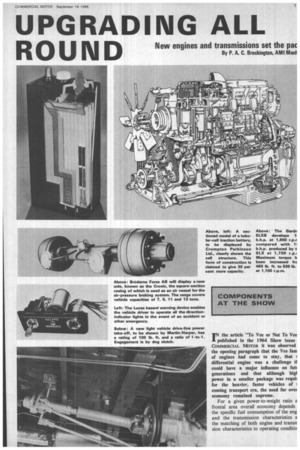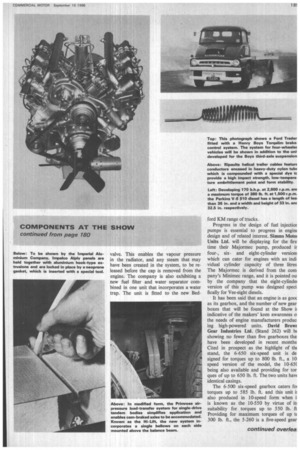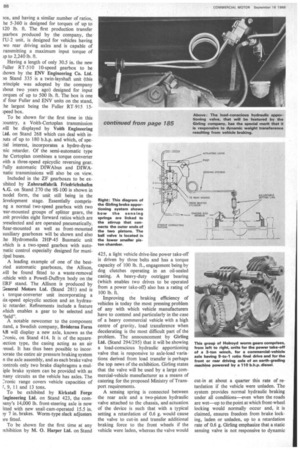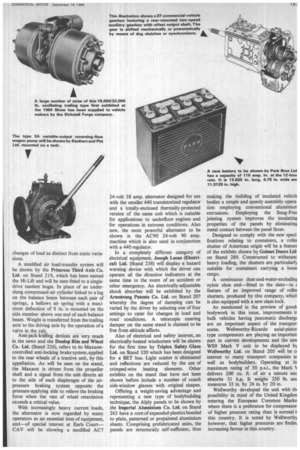COMPONENTS AT THE SHOW
Page 177

Page 178

Page 183

Page 184

Page 185

If you've noticed an error in this article please click here to report it so we can fix it.
TN the article "To Vee or Not To Vee I published in the 1964 Show issue COMMERCIAL MOTOR it was observed the opening paragraph that the Vee tam of engines had come to stay, that differential engine was a challenge tl could have a major influence on fun generations and that although higl power in a smaller package was requi, for the heavier, faster vehicles of 1 coming transport era, the need for over economy remained supreme.
For a given power-to-weight ratio a frontal area overall economy depends the specific fuel consumption of the eng and the transmission characteristics a the matching of both engine and transn sion characteristics to operating conditio ..ightness and compactness are also major onsiderations in that the first increases the iayload capacity of the vehicle and the econd its bulk capacity. Compactness arty also enable the power unit to be more avourably located with regard to axle )ading.
With the emphasis on economy the lost outstanding new diesel at Earls Court /ill be the 6LXB 10.45-litre, a derivative I' the 6LX, shown by Gardner Engines Sales) Ltd. on Stand 420. The ouput of ils unit has been increased from 150 .h.p. to 180 b.h.p. with a modest increase r.p.m. from 1,700 to 1,850, and very ommendably this has been achieved with slight but significant improvement in conomy, the minimum specific fuel conumption of the 6LXB being 0.328 lb. .h.p./hr.
This consumption may in part be !,garded as proof that the long stroke ngine is very far from obsolescence, the Toke of the 6LXB (as in the case of the LX) being 6 in. compared with a bore of .75 in.
Comparing the 6LXB with the other new nine at the Show, the Rolls-Royce Eagle, ) be exhibited by Rolls-Royce Ltd. on Stand 32 it is pertinent to emphasize that the latter produced in turbocharged form, the turboharged 260 developing 260 b.h.p. at 2,100 p.m. In common with the 205 (205 b.h.p.) and the 220 (220 b.h.p.) naturally-aspirated units the 260 has a bore of 5.125 in. and a stroke of 6 in., its capacity being 12.17 litres. No specific fuel consumption figures are yet available for this unit.
Although the Perkins Manufacturing Co. (Stand 421) will not be exhibiting a differential diesel engine this year, there is no doubt that turbocharging and the Vee family of engines have come to stay. It is to be regretted, however, that the hoped-for appearance of a turbocharged version of a well-known unit produced by one of the big companies will not in fact materialize.
Both the Cummins range of Vee engines and the more recently introduced Perkins V8.510 8.36-litre diesel are suitable for turbocharging, and it is notable that the V8.510 has a relatively long stroke, despite the fact that a shorter stroke favours lateral compactness in the case of a Vee. The two outstanding virtues of the Vee engine are its overall compactness and, in the case of the short stroke unit, the ability of the engine safely to operate at higher speeds, with a consequent increase in b.h.p. per litre and improvement in powerto-weight ratio.
A 6.354 diesel will be included in the Perkins exhibits and it is noteworthy that the maker regards the stroke-bore ratio of this unit as ideal.
Two new turbochargers will be displayed by CAV Ltd. on Stand 236, which are known as the 01 and the 02 and are suitable for engines 40/100 b.h.p. and 100/150 b.h.p. respectively, these ratings being the power developed in naturally aspirated form. It is known that CAV have made a particular study of turbocharger lubrication and that this has increased the service life and reliability of the units.
The higher pressures created by turbocharging may create piston problems in some applications, notably with regard to ring-groove wear. Pistons are to be exhibited by Specialloid Ltd. which the makers claim greatly reduce ring-groove wear by virtue of the material used. This is hyper-eutectic 20/25 per cent silicon alloy, which combines high wear resistance with a very low expansion coefficient, thus enabling cold clearances to be reduced to a minimum. A new oil-cooled piston on this stand incorporates a steel annulus, the flow of oil through which is actuated by inertia.
Engine temperature control is now being given the serious attention it deserves by an increasing number of manufacturers and it is therefore appropriate to draw particular attention to a range of three new wax-pellet thermostats to be displayed by the AC-Delco Division of General Motors Ltd. (Stand 379) who will also be showing a new range of Roto Safe pressure caps which incorporate a hand-operated safety valve. This enables the vapour pressure in the radiator, and any steam that may have been created in the system, to be released before the cap is removed from the engine. The company is also exhibiting a new fuel filter and water separator combined in one unit that incorporates a water trap. The unit is fitted to the new Bed
ford KM range of trucks.
Progress in the design of fuel injectior pumps is essential to progress in engim design and of related interest. Simms Moto! Units Ltd. will be displaying for the firs' time their Majortnec pump, produced ir four-, sixand eight-cylinder versioni which can cater for engines with an incdi. vidual cylinder capacity of three litres The Majormec is derived from the corn. pany's Minim= range, and it is pointed otr by the company that the eight-cylindei version of this pump was designed speci fically for Vee-eight diesels.
It has been said that an engine is as gooc as its gearbox, and the number of new gear boxes that will be found at the Show h indicative of the makers' keen awareness o: the needs of engine manufacturers produc ing high-powered units. David Draw Gear Industries Ltd. (Stand 262) will Ix showing no fewer than five gearboxes thal have been developed in recent months Cited in prospect as the highlight of tht stand, the 6-650 six-speed unit is de. signed for torques up to 800 lb. ft., a 10 speed version of the model, the 10-65( being also available and providing for tor ques of up to 650 lb. ft. The two units ham identical casings.
The 6-500 six-speed gearbox caters fa torques up to 585 lb. ft. and this unit h also produced in 10-speed form when i is known as the 10-550 by virtue of it suitability for torques up to 550 lb. ft Providing for maximum torques of up tt 300 lb. ft., the 5-260 is a five-speed gear )ox, and having a similar number of ratios, he 5-360 is designed for torques of up to 120 lb. ft. The first production transfer ;earbox produced by the company, the FU-2 unit, is designed for vehicles having wo rear driving axles and is capable of ransmitting a maximum input torque of ip to 2,240 lb. ft.
Having a length of only 30.5 in. the new Fuller RT-510 10-speed gearbox to be ;hown by the ENV Engineering Co. Ltd.
m Stand 335 is a twin-layshaft unit (this rinciple was adopted by the company 'bout two years ago) designed for input .orques of up to 500 lb. ft. The box is one )tfour Fuller and ENV units on the stand. .he largest being the Fuller RT-915 15;peed box.
To be shown for the first time in this -.:ountry, a Voith-Certoplan transmission will be displayed by Voith Engineering Ltd. on Stand 268 which can deal with innits of up to 180 b.h.p. and which, of spe;jai interest, incorporates a hydro-dynanic retarder. Of the semi-automatic type he Certoplan combines a torque converter with a three-speed epicyclic reversing gear. Fully automatic DIWAbus and DIWAnatic transmissions will also be on view.
Included in the ZF gearboxes to be exnbited by Zahnradfabrik Friedrichshafen 4.G. on Stand 270 the 9S-100 is shown in nodel form, the unit still being in the ievelopment stage. Essentially comprisng a normal two-speed gearbox with two sear-mounted groups of splitter gears, the init provides eight forward ratios which are )reselected and are operated pneumatically. Rear-mounted as well as front-mounted auxiliary gearboxes will be shown and also he Hydromedia 2HP-45 Busmatic unit which is a two-speed gearbox with autonatic control especially designed for muni:ipal buses.
A leading example of one of the best:ried automatic gearboxes, the Allison, will be found fitted to a waste-removal iehicle with a Powell-Duffryn body on the ERF stand. The Allison is produced by General Motors Ltd. (Stand 281) and is s torque-converter unit incorporating a ;ix-speed epicyclic section and an hydrauic retarder. Refinements include a feature which enables a gear to be selected and 'held".
A notable newcomer to the component aand, a Swedish company, Broderna Forss 11.B will display a new axle, known as the L'ronic, on Stand 414. It is of the square;ection type, the casing acting as an air 7essel. It has thus been possible to incor'orate the entire air pressure braking system n the axle assembly, and as each brake valve :ontrols only two brake diaphragms a muliple brake system can be provided with as nany circuits as the vehicle has axles. The -2ronic range covers vehicle capacities of 7,9, 11 and 13 tons.
To be exhibited by Kirkstall Forge Engineering Ltd. on Stand 423, the cornJany's 14,000 lb. front-steering axle is now itted with new snail-cam-operated 15.5 in. )37 7 in. brakes. Worm-type slack adjusters ire fitted.
To be shown for the first time at any ;xhibition by M. 0. Harper Ltd. on Stand 425, a light vehicle drive-line power take-off is driven by three belts and has a torque capacity of 100 lb. ft., engagement being by dog clutches operating in an oil-sealed casing. A heavy-duty outrigger bearing (which enables two drives to be operated from a power take-off) also has a rating of 100 lb. ft.
Improving the braking efficiency of vehicles is today the most pressing problem of any with which vehicle manufacturers have to contend and particularly in the case of a heavy commercial vehicle with a high centre of gravity, load transference when decelerating is the most difficult part of the problem. The announcement by Girling Ltd. (Stand 294/295) that it will be showing a load-conscious hydraulic apportioning valve that is responsive to axle-load variations derived from load transfer is perhaps the top news of the exhibition. Girling states that the valve will be used by a large commercial-vehicle manufacturer as a means of catering for the proposed Ministry of Transport requirements.
A sensing spring is connected between the rear axle and a two-piston hydraulic valve attached to the chassis, and actuation of the device is such that with a typical setting a retardation of 0.6 g. would cause the valve to cut-in and transfer additional braking force to the front wheels if the vehicle were laden, whereas the valve would cut-in at about a quarter this rate of retardation if the vehicle were unladen. The system provides normal hydraulic braking under all conditions—even when the roads are wet—up to the point at which front-wheel locking would normally occur and, it is claimed, ensures freedom from brake locking, laden or unladen, up to a retardation rate of 0.6 g. Girling emphasize that a static sensing valve is not responsive to dynamic changes of load as distinct from static variations.
A modified air load-transfer system will be shown by the Primrose Third Axle Co. Ltd. on Stand 219, which has been named the Hi-Lift and will be seen fitted to a singledrive tandem bogie. In place of an underslung compressed-air cylinder linked to a lug on the balance beam between each pair of springs, a bellows air spring with a maximum deflection of 8 in. is mounted on the side member above one end of each balance beam. Weight is transferred from the trailing axle to the driving axle by the operation of a valve in the cab.
Anti-jack-kafing devices are very much in the news and the Dunlop Rim and Wheel Co. Ltd. (Stand 226), refers to its Maxaretcontrolled anti-locking brake system, applied to the rear wheels of a tractive unit, by this appellation. As will be seen on the stand, the Maxaret is driven from the propeller shaft and a signal from the unit directs air to the side of each diaphragm of the airpressure braking system opposite the pressure-applying side to relieve the braking force when the rate of wheel retardation exceeds a critical value.
With increasingly heavy current loads, the alternator is now regarded by many operators as an essential item of equipment, and—of special interest at Earls CourtCAV will be showing a modified AC7 24-volt 58 amp. alternator designed for use with the smaller 440 transistorized regulator and a totally-enclosed thermally-protected version of the same unit which is suitable for applications to underfloor engines and for operations in extreme conditions. Also new, the most powerful alternator to be shown is the AC90 24-volt 90 amp. machine which is also used in conjunction with a 440 regulator.
In a completely different category of electrical equipment, Joseph Lucas (Electrical) Ltd. (Stand 238) will display a hazard warning device with which the driver can operate all the direction indicators at the same time in the event of an accident or other emergency. An electrically-adjustable shock absorber will be exhibited by the Armstrong Patents Co. Ltd. on Stand 207 whereby the degree of damping can be varied by the driver by selecting one of four settings to cater for changes in load and road conditions. A telescopic steering damper on the same stand is claimed to be free from altitude affects.
Also of electrical and safety interest, an electrically-heated windscreen will be shown for the first time by Triplex Safety Glass Ltd. on Stand 320 which has been designed for a BET bus. Light scatter is eliminated and reflections are reduced by the use of crimped-wire heating elements. Other exhibits on the stand that have not been shown before include a number of coach side-window glasses with original shapes.
Offering a weight-saving advantage and representing a new type of' bodybuilding technique, the Alply panels to be shown by the Imperial Aluminium Co. Ltd. on Stand 263 have a core of expanded plastics bonded to plain, patterned or prepainted aluminium sheets. Comprising prefabricated units, the panels are structurally self-sufficient, thus making the building of insulated vehicle bodies a simple and speedy assembly operation employing conventional aluminium extrusions. Employing the Snug-Free jointing system improves the insulating properties of the panels by eliminating metal contact between the panel faces.
Designed to comply with the new sped fications relating to containers, a rollei shutter of American origin will be a feature of the exhibits shown by Golmet Doors Ltd on Stand 289. Constructed to withstanC heavy loading, the shutters are particularly suitable for containers carrying a loose cargo.
A continuous dust-and-water-excluding nylon shoe end—fitted to the slats—is s feature of an improved range of rollei shutters, produced by this company, whicl is also equipped with a new slam-lock.
As mentioned in the preview of gooch bodywork in this issue, improvements it bulk vehicles having pneumatic discharge are an important aspect of the transpon scene. Wellworthy-Ricardo axial-pistor type compressors are playing an importani part in current developments and the nem WS9 Mark V unit to be displayed by Wellworthy Ltd. on Stand 205 will be a interest to ,many transport companies aE well as bodybuilders. Operating at it maximum rating of 30 p.s.i., the Mark N delivers 200 Cu. ft. of air a minute anc absorbs 31 h.p, It weighs 250 lb. ant measures 33 in. by 26 in. by 20 in.
Weliworthy developed the unit with till possibility in mind of the United Kingdon entering the European Common Marke where there is a preference for compressor of higher pressure rating than is normal ii this country. It is noted by Wellworthy however, that higher pressures are findin; increasing favour in this country.




















































































































































































































































































